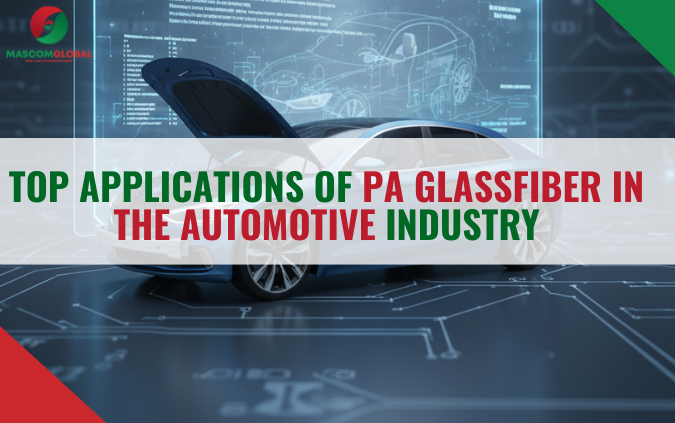The application of PA glassfiber in the automotive industry (polyamide reinforced with glass fiber) is no longer a trend but has become a revolution in the manufacturing sector. As the global automotive industry faces increasing pressure to reduce vehicle weight, improve fuel efficiency, and meet stringent emissions standards, the search for alternative materials to replace traditional metals has become more urgent than ever.
In this context, glass fiber reinforced Polyamide (PA) has emerged as a high-performance composite material solution, offering the perfect balance of mechanical strength, heat resistance, and design flexibility.
What is PA Glassfiber? A Material Overview
PA glassfiber, commonly known as glass-reinforced nylon, is a type of engineering composite plastic. It is created by combining a polyamide polymer matrix (such as PA6 or PA66) with short or long glass fibers. This process significantly improves the material’s properties compared to virgin PA resin.

- Polyamide (PA) Matrix: Provides good chemical resistance, toughness, and ease of processing through injection molding.
- Glass Fiber: Acts as a reinforcing agent, dramatically increasing stiffness, tensile strength, impact resistance, and especially dimensional stability at high temperatures.
This combination creates an ideal material for demanding applications, and the use of PA glassfiber in the automotive industry is a clear testament to that.
Top Applications of PA glassfiber in the automotive industry
Thanks to the aforementioned advantages, this composite material has been integrated into almost every system of a modern vehicle.

1. Under-the-Hood Components
This is the harshest environment, requiring materials to withstand high temperatures, vibrations, and chemical exposure. Applications of PA glassfiber in the automotive sector in this area include:
- Engine Covers: Require heat resistance, noise reduction, and an aesthetic finish.
- Air Intake Manifolds: PA glassfiber allows for the creation of complex manifold designs with smooth internal surfaces, optimizing airflow into the engine while reducing weight compared to cast aluminum.
- Radiator End Tanks: Must withstand the high pressure and temperature of the coolant, as well as resist chemical corrosion. The use of PA glassfiber in the automotive industry for this part is an industry standard.
- Transmission Housings and Drivetrain Components: Require stiffness and dimensional stability to ensure precise operation.
2. Structural and Exterior Components
The durability and formability of PA glassfiber in the automotive industry make it an ideal choice for parts that demand both function and aesthetics.
- Front-End Modules: A complex structural component that integrates headlights, the radiator, and various sensors. PA glassfiber helps reduce the weight of the front end and simplifies assembly.
- Door Handles: Need high strength to withstand frequent pulling forces and require a good surface finish.
- Mirror Housings: Require stiffness to reduce vibration and dimensional stability under various weather conditions.
- Wiper Arms: Using PA glassfiber in the automotive applications for wiper arms helps reduce weight and prevent corrosion.
3. Interior Components
Inside the cabin, materials must not only be durable but also meet safety and aesthetic standards.
- Seat Structures: Reduce the weight of the seats while still ensuring they meet crash safety standards.
- Pedal Boxes: Accelerator, brake, and clutch pedals made from PA glassfiber offer high stiffness and durability, replacing heavier metal pedal assemblies.
- Dashboard Components: The support frames and internal parts of the dashboard are made from this material to ensure rigidity and reduce squeaks and rattles.
- Paddle Shifters: Provide a solid, premium feel for the driver. The success of PA glassfiber in the automotive applications is evident in these small but important details.
4. Electrical and Electronic Systems
- Electrical Connectors: PA glassfiber provides excellent electrical insulation, dimensional stability, and the heat resistance needed for connectors in the engine bay.
- Sensor Housings: Protect critical sensors from environmental factors such as heat, humidity, and vibration.
- Fuse Boxes: Require materials with good insulation and flame-retardant properties.
Why is PA Glassfiber a Preferred Choice in the Automotive Industry?
The popularity of PA glassfiber in the automotive sector is not accidental. This material offers a range of key benefits that car manufacturers are constantly seeking:
- Lightweighting: PA glassfiber has a significantly lower density than metals (like steel and aluminum). Replacing metal parts with this composite helps reduce the overall vehicle weight, thereby improving fuel efficiency (for internal combustion engine vehicles) and extending the range (for electric vehicles).
- Superior Mechanical Strength: The glass fiber reinforcement gives the material high tensile strength and stiffness, making it strong enough to replace metal in many load-bearing applications. This is a core element for the safety and reliability of parts using PA glassfiber in the automotive industry.
- Excellent Heat Resistance: Components near the engine or transmission system must operate in high-temperature environments. PA glassfiber (especially PA66-GF) maintains its mechanical and dimensional stability even when exposed to extreme heat.
- Design Freedom and Integration: The injection molding process allows for the creation of complex-shaped parts, integrating multiple functions into a single component. This helps reduce the number of parts, simplify the assembly process, and lower production costs.
- Chemical and Corrosion Resistance: Unlike metals, PA glassfiber in the automotive applications does not corrode and is resistant to many common automotive chemicals such as oils, greases, fuels, and coolants.
The Future of PA Glassfiber in the automotive Industry
The trends of electrification and autonomous driving are opening up new opportunities for the application of PA glassfiber in the automotive industry.

- Electric Vehicles (EVs): Weight reduction is even more critical to maximize battery range. PA glassfiber is widely used for components such as battery trays, power electronics housings, and lightweight structural components.
- Sustainable Materials: Manufacturers are developing recycled or bio-based grades of PA, combined with glass fibers, to create a “greener” material that aligns with the circular economy.
The continuous advancement of material technology ensures that the role of PA glassfiber in the automotive industry will continue to be strengthened and expanded in the future.
Conclusion
From small interior details to critical load-bearing structural components under the hood, the applications of PA glassfiber in the automotive industry have proven it to be an indispensable material in modern car manufacturing. Its ability to provide high strength, heat resistance, chemical resistance, and especially weight reduction has helped manufacturers create safer, more efficient, and more environmentally friendly vehicles. As technology continues to evolve, we can fully expect more innovative and groundbreaking applications of PA glassfiber in the automotive sector, continuing to shape the appearance and performance of the cars of the future.
📩 Contact information
We have many different types of additives for your application. If you have any needs, please contact us to get the best quotation. Thank you!
Phone: (+84) 925 202 888
Gmail: info@mascomglobal.com
Address: Tien Tien Industrial, Quang Tien Commune, Hoa Binh, Vietnam
My Dinh Plaza 2 Building, 02 Nguyen Hoang Str., Nam Tu Liem Dist., Hanoi, Vietnam
Facebook: Mascom Global

